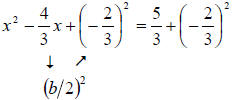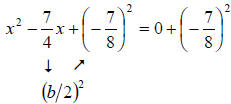Completing the Square
To complete the square for the expression x2 + bx , add
 , which is the square of
, which is the square of
half the coefficient of x . Consequently,

When solving quadratic equations by completing the square,
you must add  to both
to both
sides to maintain equality.
Completing the Square: Leading Coefficient is 1
Let’s solve the equation x 2 − 6x + 2 = 0 by completing the square.
| x2 + 6x + 2 = 0 | Original Equation |
| x2 + 6x = −2 | Subtract 2 from both sides |
 |
Divide the 6 by 2, square it, and then add to both sides |
| x2 + 6x + 9 = 7 | Simplify |
| (x + 3)2 = 7 | Perfect square trinomial |
 |
Extract square roots |
 |
Solutions |
Completing the Square: Leading Coefficient is Not 1
Let’s solve the equation 3x2 − 4x − 5 = 0 by completing the square.
If the leading coefficient of a quadratic equation is not 1, you should divide
both sides of
the equation by this coefficient before completing the square.
| 3x2 − 4x − 5 = 0 | Original equation |
| 3x2 − 4x = 5 | Add 5 to both sides |
 |
Divide both sides by 3 |
 |
Divide by 2,
square it, and then add to both sides by 2,
square it, and then add to both sides |
 |
Perfect square trinomial |
 |
Extract square roots |
 |
Solutions |
Using a graphing calculator , you can see that the two
solutions are approximately
2.11963 and –0.78630, which agree with the two graphical solutions shown below.

Completing the Square: One Term is Not Present
Let’s solve the equation 4x2 − 7x = 0 by completing the square.
As you can see, we have no constant but we will treat the problem the same as if
there
was a constant present . We skip the step of moving the constant over to the
other side of
the equation and continue on from there.
| 4x2 − 7x = 0 | Original equation |
 |
Divide both sides by 4 |
 |
Divide
 by 2, square it, and then add to both sides by 2, square it, and then add to both sides |
 |
Perfect square trinomial |
 |
Extract square roots |
 |
Solutions |
| Prev | Next |